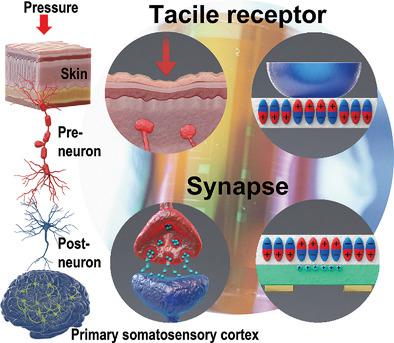Our official English website, www.x-mol.net, welcomes your
feedback! (Note: you will need to create a separate account there.)
Artificially Intelligent Tactile Ferroelectric Skin
Advanced Science ( IF 14.3 ) Pub Date : 2020-09-03 , DOI: 10.1002/advs.202001662 Kyuho Lee 1 , Seonghoon Jang 2 , Kang Lib Kim 1 , Min Koo 1 , Chanho Park 1 , Seokyeong Lee 1 , Junseok Lee 1 , Gunuk Wang 2 , Cheolmin Park 1
Advanced Science ( IF 14.3 ) Pub Date : 2020-09-03 , DOI: 10.1002/advs.202001662 Kyuho Lee 1 , Seonghoon Jang 2 , Kang Lib Kim 1 , Min Koo 1 , Chanho Park 1 , Seokyeong Lee 1 , Junseok Lee 1 , Gunuk Wang 2 , Cheolmin Park 1
Affiliation

|
Lightweight and flexible tactile learning machines can simultaneously detect, synaptically memorize, and subsequently learn from external stimuli acquired from the skin. This type of technology holds great interest due to its potential applications in emerging wearable and human‐interactive artificially intelligent neuromorphic electronics. In this study, an integrated artificially intelligent tactile learning electronic skin (e‐skin) based on arrays of ferroelectric‐gate field‐effect transistors with dome‐shape tactile top‐gates, which can simultaneously sense and learn from a variety of tactile information, is introduced. To test the e‐skin, tactile pressure is applied to a dome‐shaped top‐gate that measures ferroelectric remnant polarization in a gate insulator. This results in analog conductance modulation that is dependent upon both the number and magnitude of input pressure‐spikes, thus mimicking diverse tactile and essential synaptic functions. Specifically, the device exhibits excellent cycling stability between long‐term potentiation and depression over the course of 10 000 continuous input pulses. Additionally, it has a low variability of only 3.18%, resulting in high‐performance and robust tactile perception learning. The 4 × 4 device array is also able to recognize different handwritten patterns using 2‐dimensional spatial learning and recognition, and this is successfully demonstrated with a high degree accuracy of 99.66%, even after considering 10% noise.
中文翻译:

人工智能触觉铁电皮肤
轻巧灵活的触觉学习机器可以同时检测、突触记忆并随后从皮肤获得的外部刺激中学习。此类技术因其在新兴可穿戴和人类交互式人工智能神经形态电子产品中的潜在应用而引起了极大的兴趣。在这项研究中,一种集成的人工智能触觉学习电子皮肤(e-skin)基于带有圆顶形触觉顶栅的铁电栅场效应晶体管阵列,可以同时感知和学习各种触觉信息,被介绍。为了测试电子皮肤,将触觉压力施加到圆顶形顶栅极上,以测量栅极绝缘体中的铁电残余极化。这导致模拟电导调制取决于输入压力尖峰的数量和幅度,从而模仿各种触觉和基本突触功能。具体而言,该器件在 10000 个连续输入脉冲的过程中在长期增强和抑制之间表现出出色的循环稳定性。此外,它的变异性很低,仅为 3.18%,从而实现高性能和强大的触觉感知学习。 4 × 4 设备阵列还能够使用二维空间学习和识别来识别不同的手写图案,并且即使在考虑 10% 的噪声后,也能以 99.66% 的高精度成功证明这一点。
更新日期:2020-09-03
中文翻译:

人工智能触觉铁电皮肤
轻巧灵活的触觉学习机器可以同时检测、突触记忆并随后从皮肤获得的外部刺激中学习。此类技术因其在新兴可穿戴和人类交互式人工智能神经形态电子产品中的潜在应用而引起了极大的兴趣。在这项研究中,一种集成的人工智能触觉学习电子皮肤(e-skin)基于带有圆顶形触觉顶栅的铁电栅场效应晶体管阵列,可以同时感知和学习各种触觉信息,被介绍。为了测试电子皮肤,将触觉压力施加到圆顶形顶栅极上,以测量栅极绝缘体中的铁电残余极化。这导致模拟电导调制取决于输入压力尖峰的数量和幅度,从而模仿各种触觉和基本突触功能。具体而言,该器件在 10000 个连续输入脉冲的过程中在长期增强和抑制之间表现出出色的循环稳定性。此外,它的变异性很低,仅为 3.18%,从而实现高性能和强大的触觉感知学习。 4 × 4 设备阵列还能够使用二维空间学习和识别来识别不同的手写图案,并且即使在考虑 10% 的噪声后,也能以 99.66% 的高精度成功证明这一点。









































 京公网安备 11010802027423号
京公网安备 11010802027423号